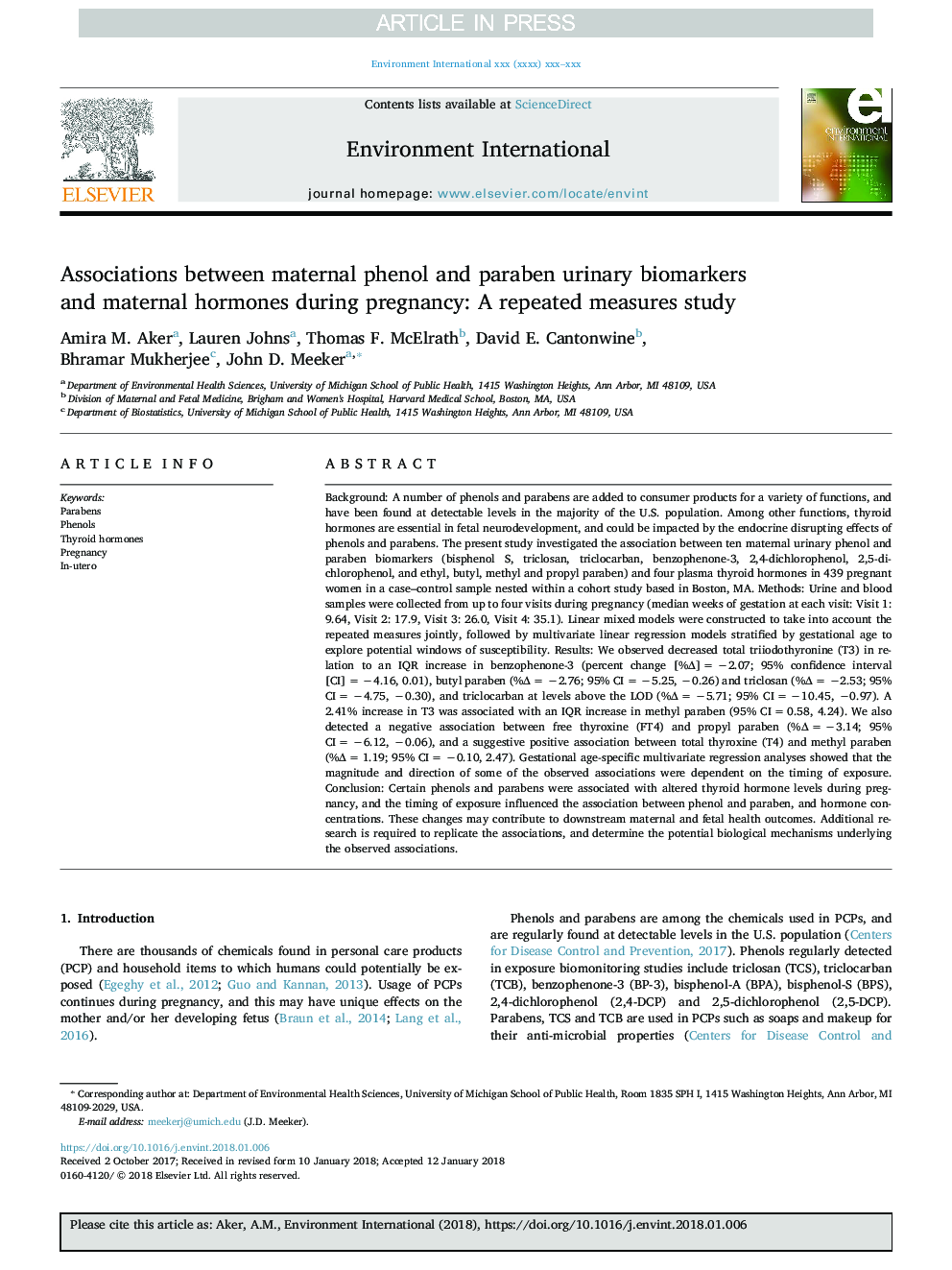| کد مقاله | کد نشریه | سال انتشار | مقاله انگلیسی | نسخه تمام متن |
|---|---|---|---|---|
| 8855405 | 1619017 | 2018 | 9 صفحه PDF | دانلود رایگان |
عنوان انگلیسی مقاله ISI
Associations between maternal phenol and paraben urinary biomarkers and maternal hormones during pregnancy: A repeated measures study
ترجمه فارسی عنوان
ارتباط بین فنل مادر و پارامترهای بیومارکرهای ادراری و هورمون های مادر در دوران بارداری: مطالعه ای برای اندازه گیری های مکرر
دانلود مقاله + سفارش ترجمه
دانلود مقاله ISI انگلیسی
رایگان برای ایرانیان
کلمات کلیدی
پارابنز، فنل ها، هورمونهای تیروئید، بارداری، در دوران جنینی،
موضوعات مرتبط
علوم زیستی و بیوفناوری
علوم محیط زیست
شیمی زیست محیطی
چکیده انگلیسی
Background: A number of phenols and parabens are added to consumer products for a variety of functions, and have been found at detectable levels in the majority of the U.S. population. Among other functions, thyroid hormones are essential in fetal neurodevelopment, and could be impacted by the endocrine disrupting effects of phenols and parabens. The present study investigated the association between ten maternal urinary phenol and paraben biomarkers (bisphenol S, triclosan, triclocarban, benzophenone-3, 2,4-dichlorophenol, 2,5-dichlorophenol, and ethyl, butyl, methyl and propyl paraben) and four plasma thyroid hormones in 439 pregnant women in a case-control sample nested within a cohort study based in Boston, MA. Methods: Urine and blood samples were collected from up to four visits during pregnancy (median weeks of gestation at each visit: Visit 1: 9.64, Visit 2: 17.9, Visit 3: 26.0, Visit 4: 35.1). Linear mixed models were constructed to take into account the repeated measures jointly, followed by multivariate linear regression models stratified by gestational age to explore potential windows of susceptibility. Results: We observed decreased total triiodothyronine (T3) in relation to an IQR increase in benzophenone-3 (percent change [%Î]â¯=â¯â2.07; 95% confidence interval [CI]â¯=â¯â4.16, 0.01), butyl paraben (%Îâ¯=â¯â2.76; 95% CIâ¯=â¯â5.25, â0.26) and triclosan (%Îâ¯=â¯â2.53; 95% CIâ¯=â¯â4.75, â0.30), and triclocarban at levels above the LOD (%Îâ¯=â¯â5.71; 95% CIâ¯=â¯â10.45, â0.97). A 2.41% increase in T3 was associated with an IQR increase in methyl paraben (95% CIâ¯=â¯0.58, 4.24). We also detected a negative association between free thyroxine (FT4) and propyl paraben (%Îâ¯=â¯â3.14; 95% CIâ¯=â¯â6.12, â0.06), and a suggestive positive association between total thyroxine (T4) and methyl paraben (%Îâ¯=â¯1.19; 95% CIâ¯=â¯â0.10, 2.47). Gestational age-specific multivariate regression analyses showed that the magnitude and direction of some of the observed associations were dependent on the timing of exposure. Conclusion: Certain phenols and parabens were associated with altered thyroid hormone levels during pregnancy, and the timing of exposure influenced the association between phenol and paraben, and hormone concentrations. These changes may contribute to downstream maternal and fetal health outcomes. Additional research is required to replicate the associations, and determine the potential biological mechanisms underlying the observed associations.
ناشر
Database: Elsevier - ScienceDirect (ساینس دایرکت)
Journal: Environment International - Volume 113, April 2018, Pages 341-349
Journal: Environment International - Volume 113, April 2018, Pages 341-349
نویسندگان
Amira M. Aker, Lauren Johns, Thomas F. McElrath, David E. Cantonwine, Bhramar Mukherjee, John D. Meeker,
